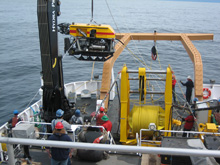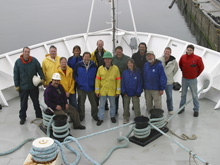
Complex ROV operations at sea require a well-coordinated team of scientists, technicians and ship’s crew. Similarly, answering basic questions about seafloor habitats requires the coordination and collaboration of various agencies and organizations, each bringing their unique skills and resources. Click image for larger view and image credit.
Performing Science Through Partnerships
Jeff Hyland
National Centers for Coastal Ocean Science
Ed Bowlby
Olympic Coast National Marine Sanctuary
This project demonstrated the benefit of research partnerships that match resources to fulfill common coastal management goals. In 2003, the National Centers of Coastal Ocean Science (NCCOS) and the National Marine Sanctuary Program (NMSP), both within NOAA’s National Ocean Service, agreed to coordinate research that demonstrated the use of effective science to characterize sanctuary resources, monitor potential changes due to natural and human factors, and support management actions for their conservation and protection. This study is a follow-up to a pilot effort funded and carried out in 2004 by NCCOS and NMSP with in-kind support from the Makah Tribe, Northwest Indian Fisheries Commission, the University of Washington, and the Marine Conservation Biology Institute. Our 2006 investigation continues under the NCCOS-NMSP agreement through the involvement of the three NCCOS and NMSP co-Principal Investigators.

Back Row (left to right): Reuben Mills, Jeff Hyland, Dean Steinke, Ian Murdock, Keith Tamburri, Steve Bucklew, Peter Etnoyer, Vince Auger. Front Row (left to right): Roger Adamson, Curt Whitmire, Robert Steelquist, Keith Shepherd, Mary Sue Brancato, Ed Bowlby. Click image for larger view and image credit.
The success of the June 2006 survey, including the remarkable photographs of fascinating deep-sea coral and sponge communities within the sanctuary, and their value as habitat for other fish and invertebrate species, clearly addresses the mission of this important partnership agreement. Other agency partners contributing to this success include Curt Whitmire of NOAA Fisheries’ Northwest Fisheries Science Center, the officers and crew of the NOAA Ship McArthur II, and Farron Wallace and Eric Eisenhardt of the Washington Department of Fish and Wildlife. The private research sector was represented by Peter Etnoyer, Harte Research Institute. The maritime technology industry was represented by ROPOS ROV, operated by the Canadian Scientific Submersible Facility of Sidney, British Columbia. The 2006 study was made possible through primary funding from NOAA’s Office of Ocean Exploration, and supplemental funding from NCCOS, OCNMS, and the National Underwater Research Program. Work is ongoing to process samples and analyze data from this project. Ultimately, our goal is to characterize the distribution, abundance and diversity of these resources, evaluate their vulnerability to potential environmental risks, and to provide new information to help support future management decisions regarding the need for additional conservation measures in such unique habitats within Olympic Coast National Marine Sanctuary.
Sign up for the Ocean Explorer E-mail Update List.













